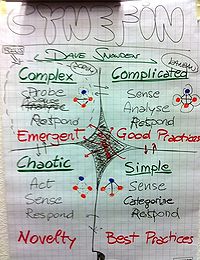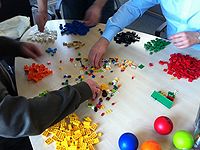The cynefin LEGO game
This page is a part of the WikiPage: The Cynefin Framework
The exercise is copied directly from http://www.agile42.com, and should be used for the readers to get a better understanding of the Cynefin Framework.
Under licence from: http://creativecommons.org/licenses/by-sa/3.0/de/
Contents |
LEGO game
A game to let you experience four of the five domains of Dave Snowden’s Cynefin framework.
Using Lego, you go through four exercises where the problem to solve and the context you work in is designed to create a simple, complicated, complex and chaotic system. While it does not introduce you to the full potential of the sense-making framework, it is well suited to get a first impression and raise interest in learning more about it! Although Cynefin is at the heart of this excercise, the debriefing focuses on outcome that is not necessarily part of the model.
When leading or managing agile transitions, it is important to know what type of system you are dealing with. Playing this game shows you how to decode what is happening in terms of organisational structures and communication in that specific system. Once you are able to do this, you can appreciate the consistency of your communication style with the related system, as well as choose more appropriate tools to set direction and coach.
Timing
The game shouldn’t take more than 60 minutes.
Material and Environment
Tables for groups of three/four, about 200 bricks of Lego in 6-10 colours in different sizes with about 10% special bricks (flowers, wheels, ...) per table.
Draw the diagram above on a flip chart. Only draw the lines in the middle, you will fill the diagram on the way (people should experience the four domains before conceptualising them with you).
You play one exercise for each of the domains, as described below. For each exercise:
- Explain the rules until there are no questions
- Start the exercise on all tables
- Track the time (but do not set a timebox)
- Capture smallest and largest time-to-completion
- When all teams are finished, give them 2 min for in-team reflection
- Share the findings, use debriefing questions.
- Draw the details for this domain on the flip chart and connect to the teams’ findings.
- Draw the communication structure and decision making structure observed during this exercise.
Exercise 1: Simple
The Challenge “Sort the bricks into colours, as quickly as possible. Create one heap for all special pieces. Decide in your team which pieces you want to treat as special.”
Debriefing
- How much time did you need for planning?
- How was the communication? How many leaders/followers were in your team?
- You will notice that common Best Practices arise from different groups
- Analyse the communication structure and the way people took decision and agree on what to do, you should notice the Top-Down Communication pattern, where one person proposed “the” way of solving the problem and the others just followed. Not much peer-to-peer communication will be going on during the exercise, at least not about how to do things, but more
Exercise 2: Complicated
The Challenge Build a structure, as quickly as possible, according to the following rules:
- At least 20 bricks high
- Regular colour pattern
- Every new block that you add to the structure can’t be bigger than the one below it
Debriefing
- What felt different compared to the simple problem?
- How much time did you need for planning?
- How was the communication? How many leaders/followers were in your team?
- In this case you will notice that possibly every team adopted different practice, producing different results. There is no Best Practice but many Good Practices.
- Analyse the communication structure and the way people took decision and agree on what to do, you should notice the Expert Communication pattern, where everyone tried to propose a possible solution. Some teams at this point may enter in analysis-paralysis, consider this as an invitation to retrospect on the role of one member facilitating the group.
Exercise 3: Complex
The Challenge “Decide in 30 seconds to build either an animal or a vehicle. After that you work according to the following rules:
- As in exercise 2, you need to create a regular colour pattern.
- Each colour of bricks must only be touched by one person in your team.
- You are not allowed to talk.
- Every minute, you need to switch tables, taking your unfinished work with you (but not the material).”
Debriefing
- What felt different compared to the simple/complicated problem?
- How was the communication? How many leaders/followers were in your team?
- What kind of feedback did you have to guide you towards a solution?
- Would it have made a difference if you had had five minutes to talk and plan before you started building?
- Here you should notice a clear emergent behaviour, many people end up surprised on how the ban of verbal communication—obviously it is a game—actually keeps them from entering long discussions, while the probing in building something together turned out to spark new ideas and inspiration at every step. Consider comparing the time with the previous exercise, normally it doesn’t differ too much, despite the fact that the challenge is complex.
Exercise 4: Chaotic
The Challenge “Your task is similar to the last one, but now you need to create a building or a plant. At random times, the facilitator will touch a team member’s shoulder and indicate another table. That person then immediately joins a different team.”
They are still not allowed to talk. For a lost teammate they might get someone back, but not immediately. (That leads to them thinking they miss a person dealing with a certain colour, which is actually not true, if you read the rule. You do not tell them it is not true).
Debriefing
- What felt different compared to the complex problem/situation?
- How was the communication? How many leaders/followers were in your team?
- How did it feel to loose a team member? How to join another team?
- Why does this small change make such a big difference?
- Here you should be able to appreciate that communication was mostly inexistent after a while, that people gave up trying to communicate, they rather start doing and get stopped by others (Act and then Probe). In particular people will feel - as opposed to the previous exercise - completely demotivated and frustrated.
Notes
The simple exercise typically gets a quick and easy solution. One player suggests something obvious and the others follow.
The complicated exercise needs a bit of planning, typically everybody suggests something, a quick decision is made and process is adapted according to feedback during the build.
The complex exercise doesn’t get better with more planning. The right process emerges and is continually adapted. The sooner teams start to build, the sooner they feel comfortable. It helps if all team members know what the animal/vehicle they want to build actually looks like.
The chaotic exercise leads to quite surprising, sometimes not very good solutions (see the building without roof in the picture). People feel uncomfortable all the time, the solution takes longer than before. Especially for managers, this is an aha-experience: “So this is how it feels to change a team...”



